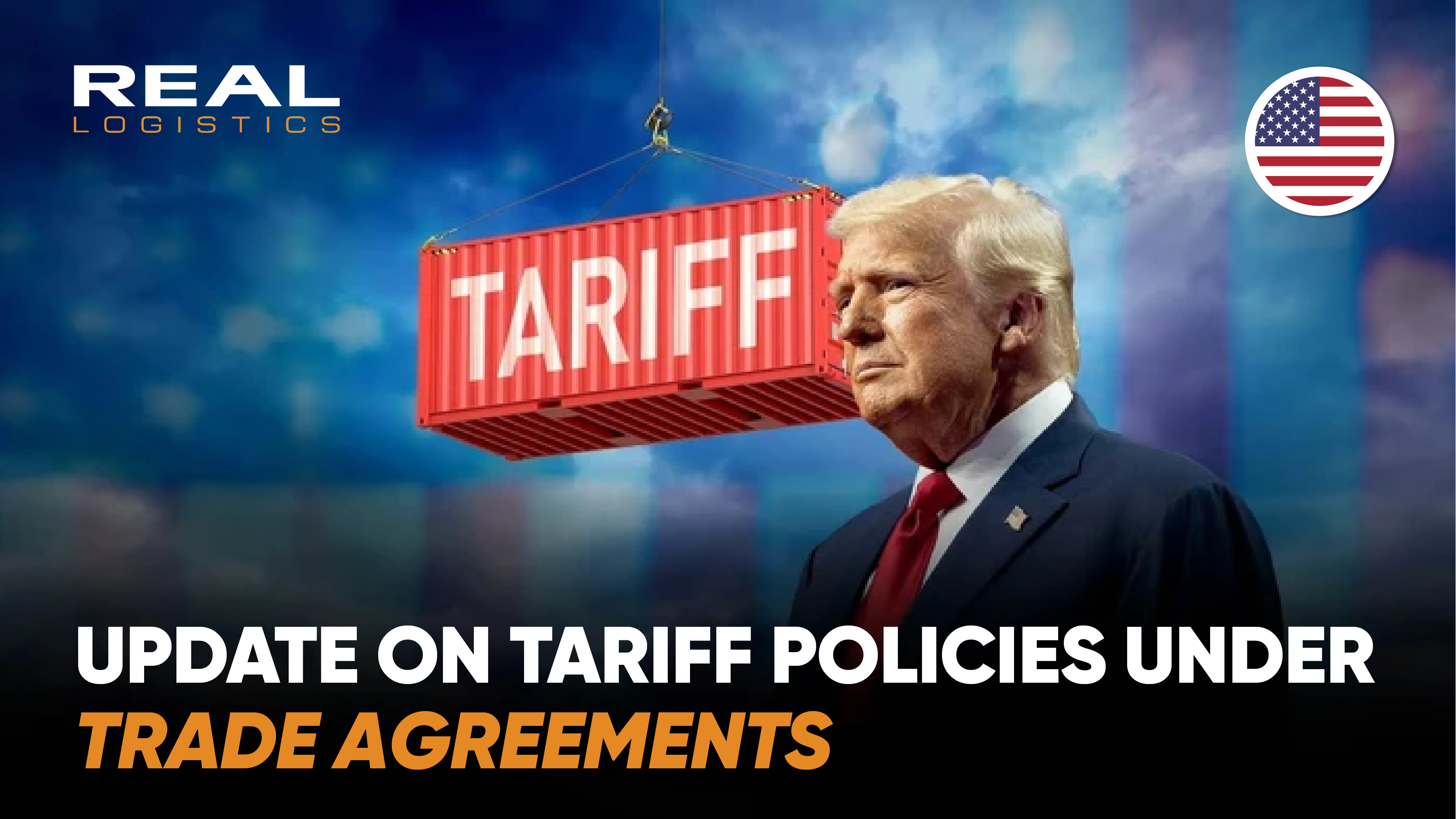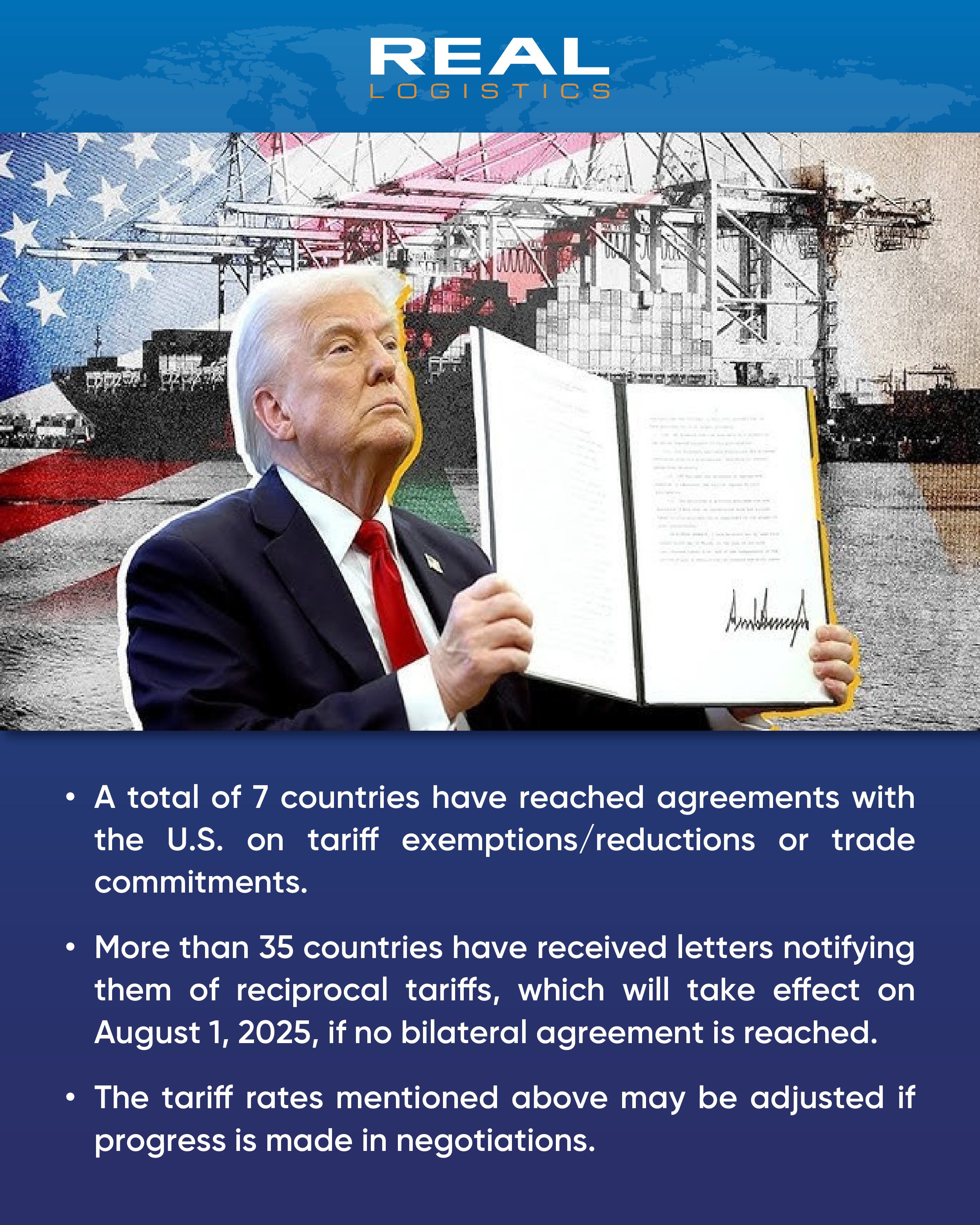US Tariff Policy Update: Summary of Latest Trade Agreements and Tariff Notifications
 The trade and tariff policies of the United States have consistently been pivotal factors influencing global supply chains and import-export activities. Since January 2025, with President Donald Trump's return to office, actions related to "reciprocal tariffs" have led to significant developments.
The trade and tariff policies of the United States have consistently been pivotal factors influencing global supply chains and import-export activities. Since January 2025, with President Donald Trump's return to office, actions related to "reciprocal tariffs" have led to significant developments.
Logistics recognizes the necessity of accurate and timely updates on the US tariff situation. This article will synthesize and provide a direct overview of completed trade agreements and a list of countries that have received tariff notifications from the US, as of July 28, 2025.
1. "Reciprocal tariff" policy: Key developments and timeline
The US "reciprocal tariff" policy has been implemented according to a specific schedule, triggering a wave of global trade negotiations. Here are the key milestones:
- April 2, 2025: President Trump announced the imposition of widespread "reciprocal tariffs" on most goods imported into the US, under the International Emergency Economic Powers Act (IEEPA).
- April 5, 2025: A baseline tariff of 10% officially took effect on nearly all imports into the US.
- May 2025: The US Court of International Trade (USCIT) ruled that the IEEPA tariffs were illegal. However, just one day after this ruling, the federal appeals court in Washington D.C. temporarily suspended the USCIT's decision while reviewing the Trump administration's appeal.
- June 26, 2025: A preliminary agreement between the US and China was reached regarding certain trade issues.
- July 2, 2025: A trade agreement between the US and Vietnam was announced.
- July 27, 2025 (US time, last night): The US and the European Union (EU) reached a historic trade agreement, ending the transatlantic tariff deadlock and preventing a full-scale trade war.
- August 1, 2025: The final deadline for many countries to reach trade agreements with the US, otherwise they will face higher tariffs under the "reciprocal tariff" policy.
The recently concluded US-EU agreement is a prominent example of how this policy is reshaping trade relations. The applied tariff rate is 15% for most EU goods (including automobiles), significantly lower than the 30% rate President Trump had previously threatened. In return, the EU committed to purchasing $750 billion in energy from the US and making an additional $600 billion in investments in the country.
2. Comprehensive update of US trade partner countries/blocs
Below is a detailed summary table of trade agreement statuses and related tariff rates, compiled by Real Logistics from reputable news sources and trade reports:
Table 1: Countries/Blocs that have Completed or Adjusted Trade Agreements with the US
| Country / Bloc | Agreement Status | Applied Tariff Rate on US Imports (if applicable) | Key Terms/Commitments (if any) | Notes |
| Japan | Completed | 15% | Japan to invest >$550 billion in US, increase US goods imports | (Rate adjusted down from 25%) |
| Philippines | Completed | 19% | Philippines to exempt >99% of US goods from tariffs | |
| Indonesia | Completed | 19% | Indonesia to import >$22.7 billion in US goods | (Rate adjusted down from 32%) |
| Vietnam | Completed | 20% (40% for transshipped goods from China) | Vietnam to exempt US goods from tariffs | |
| United Kingdom (UK) | Completed | 10% (automobiles), duty-free for aircraft parts | UK exempts aircraft-related component tariffs | |
| European Union (EU) | Completed | 15% for most EU goods | EU exempts many sectors, major investment agreement in US | |
| China | Under Negotiation | 10% (temporary application) | China to provide rare earths, US to temporarily reduce sanctions | Negotiations ongoing, potential extension of tariff truce period |
Table 2: Countries that have Received "Reciprocal Tariff" Notification Letters from the US
| Country | Proposed "Reciprocal Tariff" Rate (%) |
| South Korea | 25% |
| South Africa | 30% |
| Kazakhstan | 25% |
| Malaysia | 25% |
| Myanmar | 40% |
| Laos | 40% |
| Tunisia | 25% |
| Bosnia & Herzegovina | 30% |
| Bangladesh | 35% |
| Serbia | 35% |
| Cambodia | 19% |
| Thailand | 19% |
| Jordan | 20% |
| Iraq | 30% |
| Israel | 17% |
| Lesotho | 50% |
| Libya | 30% |
| Madagascar | 47% |
| Malawi | 17% |
| Mauritius | 40% |
| Moldova | 25% |
| Mozambique | 16% |
| Namibia | 21% |
| Nauru | 30% |
| Nicaragua | 18% |
| Nigeria | 14% |
| North Macedonia | 33% |
| Norway | 15% |
| Pakistan | 29% |
| Sri Lanka | 30% |
| Switzerland | 31% |
| Taiwan | 32% |
| Vanuatu | 22% |
| Venezuela | 15% |
| Zambia | 17% |
| Zimbabwe | 18% |

(These proposed tariffs are expected to apply from August 1, 2025, if no trade agreement is reached before the deadline.)
Note: Tariff policies are continuously being negotiated and updated as the August 1, 2025 deadline approaches. Rates may change based on final negotiation outcomes.
3. Conclusion
The rapid changes in US trade and tariff policies demand thorough preparation and flexible strategies from businesses. A clear understanding of each tariff rate, term, and commitment will help you optimize costs, avoid potential risks, and ensure a smooth-running supply chain.
Real Logistics is committed to closely monitoring all developments, providing timely information, and offering optimal logistics solutions to help your business overcome challenges and seize opportunities in this dynamic international trade environment.
Contact Real Logistics today for in-depth consultation on logistics solutions tailored to the new tariff policies!
—————————————
Real Logistics Co.,Ltd
👉 Facebook: Real Logistics Co.,Ltd
☎️ Hotline: 028.3636.3888 | 0936.386.352
📩 Email: info@reallogistics.vn | han@reallogistics.vn
🏡 Address: 39 - 41, B4 Street, An Khanh Ward, Ho Chi Minh
G2 Floor, No. 51, Quan Nhan Street, Thanh Xuan Ward, Hanoi

